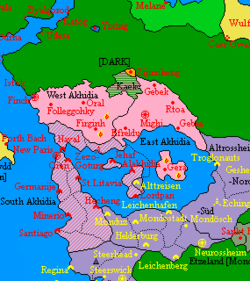East Akhidia
| Kingdom of East Akhidia Sark Akhiďą Físaqła | |||
| |||
| Motto: | |||
| Anthem: Ahkiď Įhđiqk | |||

| |||
| Map versions | 17.5.7 - | ||
| Capital | Mighi | ||
| Largest city | Mighi | ||
| Official language(s) | Akhidian | ||
| Official religion(s) | Nazarene | ||
| Demonym | East Akhidian | ||
| - Adjective | East Akhidian | ||
| Government | Monarchy | ||
| - King | Matthew I | ||
| - Crown Princess | Lorena | ||
| - Legislature | Ahidar | ||
| Establishment | 1707 AN | ||
| Area | sq.km | ||
| Population | 1,000,000 (est) | ||
| Currency | Akhidian Zendert | ||
| Abbreviation | EAK | ||
| Mains electricity | |||
| Driving side | |||
| Track gauge | |||
| Calendar | |||
| Time zone(s) | CMT -10:00 | ||
| National website | |||
| National forum | |||
| National animal | Hyena | ||
| National food | Burrito | ||
| National drink | Akhidian Paradise Vine | ||
| National tree | Dracaena cinnabari | ||
East Akhidia (Akhidian: Sark Akhiďą), officially the Kingdom of East Akhidia (Akhidian: Sark Akhiďą Físaqła), was a monarchy in central Cibola. A member of the Akhidian Confederation, it was one of the three successor states to the Kingdom of Akhidia. Its capital and largest city was Mighi.
Etymology
The name Akhidia is commonly believed to derive from the legendary Ark of the Ahit, a mysterious artefact said to bestow fabulous riches upon whomever finds it. An alternative theory holds that the country is named for the mythical Knights of Ahd, a band of courageous warriors who swore an oath to defend the ancestors of the royal House of Zezo. There is little firm historical evidence for either explanation and a definitive answer is unlikely to be found.
History
Government and politics
Administrative divisions
East Akhidia was subdivided into six provinces, named after their principle city. Five of these- Mighi, Gebea, Rtoa, Efreldu and Gebek- were situated on the Cibolan mainland, whereas the sixth comprised the isle of Gera. The provinces were theoretically administered by governors appointed by the monarch, but in practice power in each locality tended to be concentrated in the hands of local elites.
In Gera Province, the authority of the governor was largely restricted to the provincial capital due to the Al-Ramo insurgency.
| Flag | Province | Population | Capital |
|---|---|---|---|
| Mighi | 330,000 | Mighi | |
| Gebea | 179,000 | Gebea | |
| Rtoa | 149,000 | Rtoa | |
| Efreldu | 100,000 | Efreldu | |
| Gebek | Gebek | ||
| Gera | Gera |
Foreign Relations
| Nation | Status | Visa Policy | Notes |
|---|---|---|---|
| Neutral | Visa required | ||
| Friendly | Visa required | Treaty 1699 AN | |
| Friendly | Visa on arrival, 10 days per year | Treaty 1704 AN | |
| Friendly | Visa-free travel, 90 days per year | Treaty 1706 AN | |
| Friendly | Visa-free travel, 90 days per year | Treaty 1703 AN | |
| Friendly | Visa-free travel, 90 days per year | Treaty 1704 AN | |
| Friendly | Visa-free travel, 90 days per year | Treaty 1705 AN |
Demographics
East Akhidia had a population estimated at around one million. Accurate demographic information was scare owing to the government's inability to conduct a recent census due to the fragile security situation, together with the destruction of records during the Crisis of 1706 AN.
Ethnic groups
East Akhidia was home to three major ethnic groups. The Batii, a Matbaic people originally from Eastern Cibola, accounted for an estimated 45% of the population. The Fentoians, who compromised approximately 30% of the population, were the second largest group. Cibolan Saxons were the third largest group; concentrated primarily on the island of Gera, they made up some 19% of the total population.
Relationships between the principle ethnic groups were uneasy, in large part due to the historical favouritism shown towards the Batii people by the Akhidian givernment.

